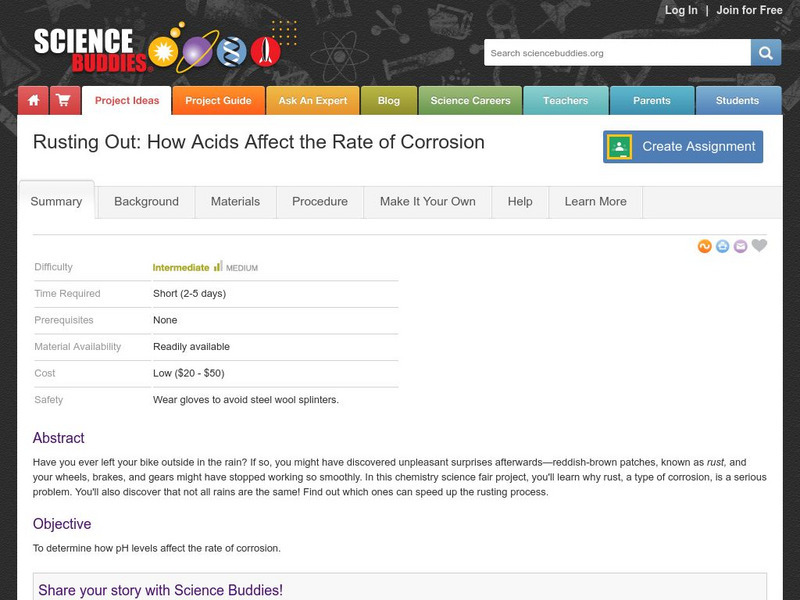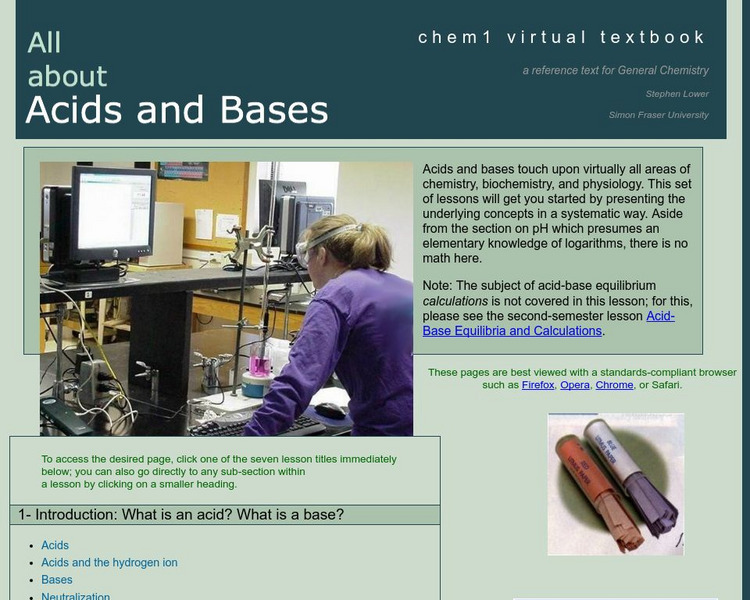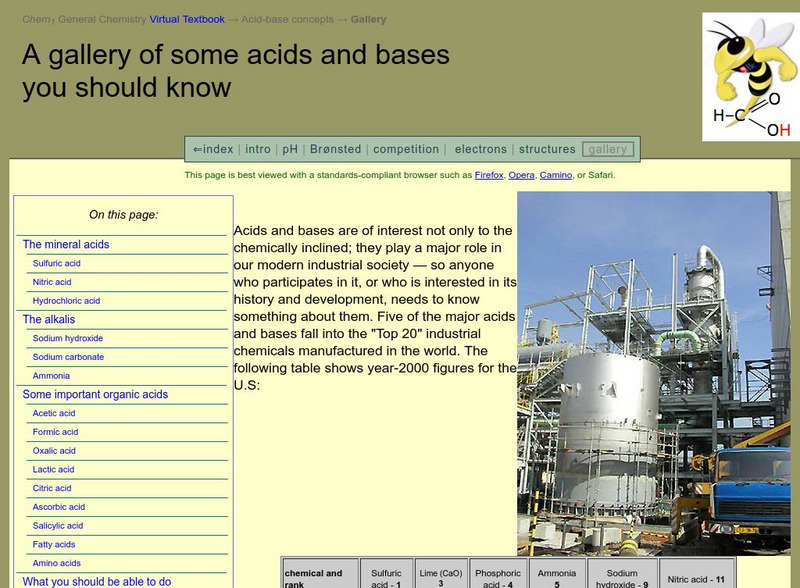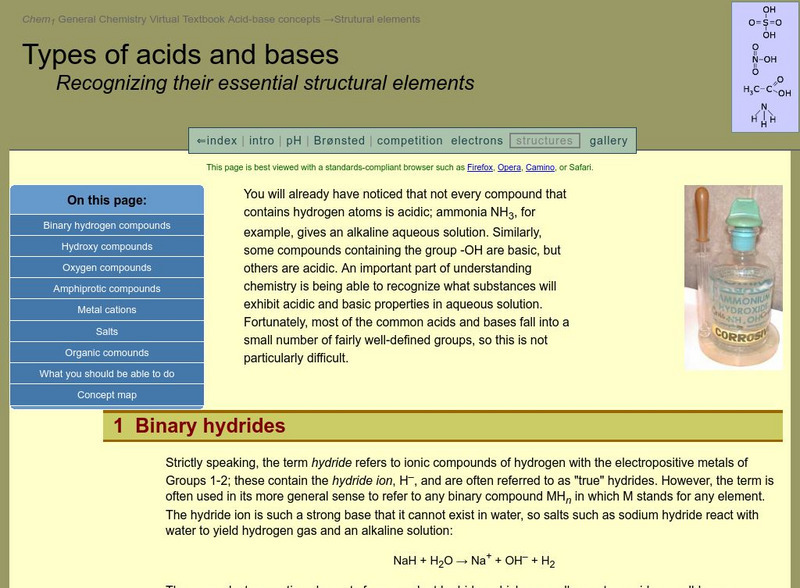Hi, what do you want to do?
Curated OER
An Introduction to Acids and Bases
Students explore acids and bases. In this instructional activity about acids and bases, students do an experiment to test certain items to determine what they are. Students use cabbage and litmus paper as indicators. Students understand...
Curated OER
Acid or Base? Toxie's On The Case!
For this chemistry worksheet, students read about the differences between substances that are acids and bases. They read about Litmus dye and the pH scale. They experiment with six household substance by testing them with litmus paper to...
Curated OER
Strings and Things: An Investigation into pH
Young scholars test the pH of everyday substances. In this chemistry activity, students test the pH of household substances using litmus paper to classify substances as acids or bases, then use pH to test the validity of the claim that...
Curated OER
Acids and Bases
In this acids and bases worksheet, students solve 10 problems and short answer questions on acid and bases concentration. They calculate the pH and pOH of solutions.
Curated OER
Acids and Bases
Students analyze everyday materials to determine whether they are acids, bases, or neutral. For this chemistry lesson, students investigate the pH of various house hold products. They discuss why it is important to know if substances are...
Curated OER
How Can You Test Your Soil?
Students investigate chemicals in soil samples. In this soil science instructional activity, students test local soil to measure the pH, nitrate, phosphate, and potassium content.
Curated OER
Identifying Acids and Bases
Sixth graders observe the physical and chemical change that can occur in an acid and a base. In this acids and bases lesson plan, 6th graders use cabbage juice to identify, compare, and contrast acids and bases.
Curated OER
Determining pH
Students evaluate pH levels through a solubility experiment. In this pH levels instructional activity, students list characteristics of acids and bases. Students complete their own pH level experiment. Students go to the GEMS Alien Juice...
Curated OER
Chemical Magic
Students identify acids and bases. In this chemistry lesson, students use red cabbage juice as an indicator of whether the liquid is an acid or base. Students discuss the results.
Curated OER
Acidic Apples and Basic Belches
Students determine whether everyday consumables are acidic or bases. They investigate, in groups, the difference between acids and bases. They determine which substance tested would be most effective in treating heartburn and why.
American Chemical Society
Inquiry in Action: Color Changes With Acids and Bases
In this lab activity, students will learn how red cabbage can be used as an indicator of an acid or base by looking at its color changes.
Georgia Department of Education
Ga Virtual Learning: Chemistry: Acids, Bases, and Salts
An interactive module where students build upon the discussion of solutions, but specifically concentrate on special types of solutions, acids and bases.
Georgia Department of Education
Ga Virtual Learning: Physical Science: Solutions Chemistry
Through interactive puzzles, informational text and video clips, students will investigate the properties of solutions.
PBS
Pbs Learning Media: Acids and Bases: Making a Film Canister Rocket
ZOOM cast members mix different amounts of baking soda and vinegar to see which combination produces the most carbon dioxide for launching a film-canister rocket. [3:23]
University of Arizona
The Biology Project: Biochemistry: Acids and Bases Problem Set
How well do you know your acids and bases? This resource will access your understanding and provide tutorials to help you with areas of weakness.
University of Alberta
The University of Alberta: Separation of Acids, Bases and Neutral Compounds
As a chemist, you will learn to deal with complex mixtures of many compounds. In this interactive activity, you will learn the basis of separations using acid-base extraction. In the virtual lab you will simulate an actual experiment and...
Science Buddies
Science Buddies: Project Ideas: How Acids Affect the Rate of Corrosion
In this chemistry science fair project, students will investigate how pH levels affect the rate of a common form of corrosion, called rusting. The Science Buddies project ideas are set up consistently beginning with an abstract,...
Science Education Resource Center at Carleton College
Serc: Investigating Acids and Bases: Strong vs Weak
In this chemistry lab activity, students will study acids/bases before learning how titration data is used to determine an unknown concentration. It is an investigation of the pH curve and an assessment of student's understanding of...
Simon Fraser University
Chem1 Virtual Textbook: Acid Base Equilibria
Learn about acid-base equilibria and calculations in this Chem1 Virtual e-Textbook.
Simon Fraser University
Chem1 Virtual Textbook: All About Acids and Bases
Acting as an overview from the General Chemistry Virtual Textbook, this site explores acids and bases and various topics connected to them, including electron pairs, proton donors, proton acceptors, acid-base reactions, and more.
Simon Fraser University
Chem1 Virtual Textbook: Some Important Organic Acids
Acting as an overview from the General Chemistry Virtual Textbook, this site explores a variety of organic acids including acetic acid, formic acid, oxalic acid, lactic acid, citric acid, ascorbic acid, and more.
Simon Fraser University
Chem1 Virtual Textbook: Types of Acids and Bases
Acting as an overview from the General Chemistry Virtual Textbook, this site explores topics related to the various types of acids and bases. The topics covered include binary hydrogen compounds, hydroxy compounds, oxygen compounds, and...
American Chemical Society
Middle School Chemistry: Chapter 6: Chemical Change
Twelve interactive chemistry lessons about chemical changes complete with handouts and animations.
University of Colorado
University of Colorado: Ph Et Interactive Simulations: P H Scale
In this advanced simulation, students experiment with changing the ion ratios in solutions and thus the pH. The experiment can be viewed on a macroscopic or microscopic level, or customized.



























